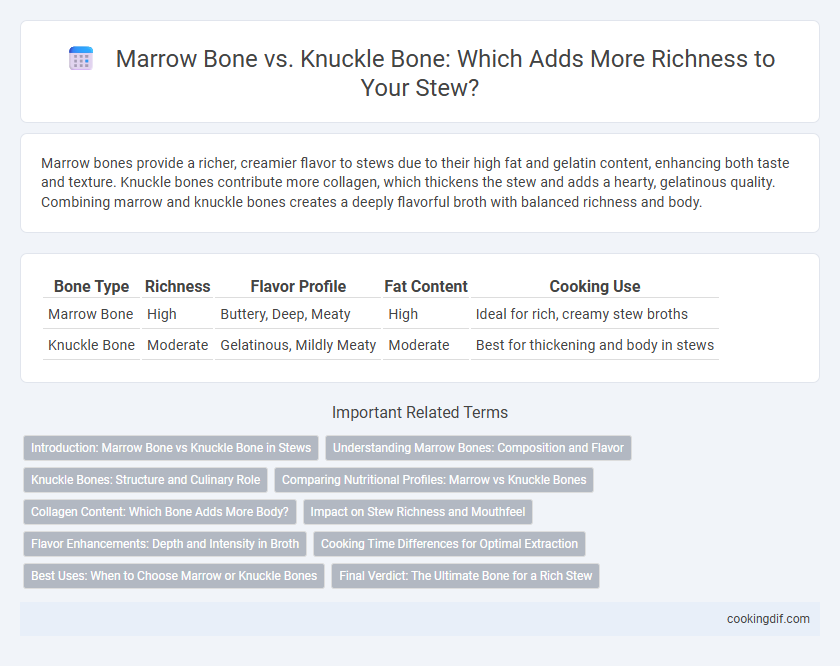Marrow bones provide a richer, creamier flavor to stews due to their high fat and gelatin content, enhancing both taste and texture. Knuckle bones contribute more collagen, which thickens the stew and adds a hearty, gelatinous quality. Combining marrow and knuckle bones creates a deeply flavorful broth with balanced richness and body.
Table of Comparison
| Bone Type | Richness | Flavor Profile | Fat Content | Cooking Use |
|---|---|---|---|---|
| Marrow Bone | High | Buttery, Deep, Meaty | High | Ideal for rich, creamy stew broths |
| Knuckle Bone | Moderate | Gelatinous, Mildly Meaty | Moderate | Best for thickening and body in stews |
Introduction: Marrow Bone vs Knuckle Bone in Stews
Marrow bones deliver a rich, creamy texture and deep flavor to stews due to their high fat content and gelatinous marrow, enhancing overall mouthfeel. Knuckle bones, containing more cartilage and connective tissue, contribute a robust, gelatin-rich broth that thickens stews and adds a hearty, savory profile. Choosing between marrow and knuckle bones depends on the desired balance of richness and gelatinous texture in stew preparation.
Understanding Marrow Bones: Composition and Flavor
Marrow bones contain rich, fatty marrow that melts into a velvety, savory broth, contributing deep umami and a silky texture to stews. Knuckle bones, in contrast, provide more gelatin due to their high collagen content, resulting in a thicker, more gelatinous consistency that enhances body and mouthfeel. Understanding the balance between marrow's richness and knuckle bone's gelatinous properties allows cooks to craft stews with optimal flavor complexity and texture.
Knuckle Bones: Structure and Culinary Role
Knuckle bones feature a dense, gelatin-rich structure with abundant collagen, enhancing the depth and body of stews when simmered slowly. Unlike marrow bones, knuckle bones release a natural gelatin that thickens broths and adds a velvety texture crucial for hearty, savory dishes. Their culinary role is vital in traditional stews, providing both flavor complexity and nutritional benefits from connective tissues.
Comparing Nutritional Profiles: Marrow vs Knuckle Bones
Marrow bones provide a rich source of healthy fats, collagen, and essential minerals such as calcium and phosphorus, contributing to improved joint health and skin elasticity. Knuckle bones are lower in fat but high in protein and connective tissue, making their broth richer in gelatin and amino acids like glycine and proline, which support gut health and muscle repair. Nutritionally, marrow bones offer higher fat content and energy density, while knuckle bones deliver more protein and collagen precursors, ideal for bone broth aimed at joint and digestive benefits.
Collagen Content: Which Bone Adds More Body?
Marrow bones excel in richness due to their high fat and marrow content, imparting a deep, creamy texture to stews. Knuckle bones, packed with dense connective tissue, provide superior collagen levels that break down into gelatin, enhancing the stew's body and mouthfeel. For maximum collagen extraction and a fuller-bodied stew, knuckle bones are the preferred choice, while marrow bones add additional richness and flavor complexity.
Impact on Stew Richness and Mouthfeel
Marrow bone contributes a deep, velvety richness to stew through its high fat content and gelatin, creating a silky mouthfeel. Knuckle bones provide a robust collagen source that thickens the broth, enhancing body and giving a satisfying, gelatinous texture. Combining marrow and knuckle bones maximizes both flavor depth and mouth-coating richness in stew.
Flavor Enhancements: Depth and Intensity in Broth
Marrow bones provide a rich, creamy texture and intense umami flavors that deepen the broth's overall profile, offering a buttery mouthfeel and gelatinous consistency when cooked slowly. Knuckle bones add a robust, savory depth with high collagen content, contributing to a thicker, more gelatinous broth that enhances mouth coating and body. Combining marrow and knuckle bones balances richness and intensity, creating a complex, flavorful stew base with optimal depth and aroma.
Cooking Time Differences for Optimal Extraction
Marrow bones yield richer, creamier stock due to higher fat content compared to knuckle bones, which provide more gelatin for a thicker texture. Marrow bones require shorter cooking times, typically 2-3 hours, to avoid over-extraction and bitterness, while knuckle bones benefit from longer simmering of 6-8 hours to fully release collagen and nutrients. Optimizing cooking time based on bone type ensures maximum flavor and desired consistency in stews.
Best Uses: When to Choose Marrow or Knuckle Bones
Marrow bones are prized for their rich, creamy texture and intense flavor, making them ideal for slow-cooked dishes like bone marrow butter, soups, and broths where depth is essential. Knuckle bones contain more collagen and gelatin, perfect for creating rich, silky stocks and sauces that benefit from long simmering to extract maximum body. Choose marrow bones when you want luxurious richness and knuckle bones when aiming for a gelatinous, hearty texture in your culinary preparations.
Final Verdict: The Ultimate Bone for a Rich Stew
Marrow bones deliver deep, velvety richness with their high fat content, infusing stews with a luxurious mouthfeel and intense flavor, while knuckle bones contribute gelatinous texture and a lighter, savory broth due to their collagen-rich composition. The final verdict for the ultimate bone in a rich stew favors marrow bones, as their creamy marrow enhances depth and richness unmatched by knuckle bones. Employing marrow bones guarantees a soul-satisfying stew with robust taste and a luscious, smooth consistency.
Marrow bone vs knuckle bone for richness Infographic

 cookingdif.com
cookingdif.com